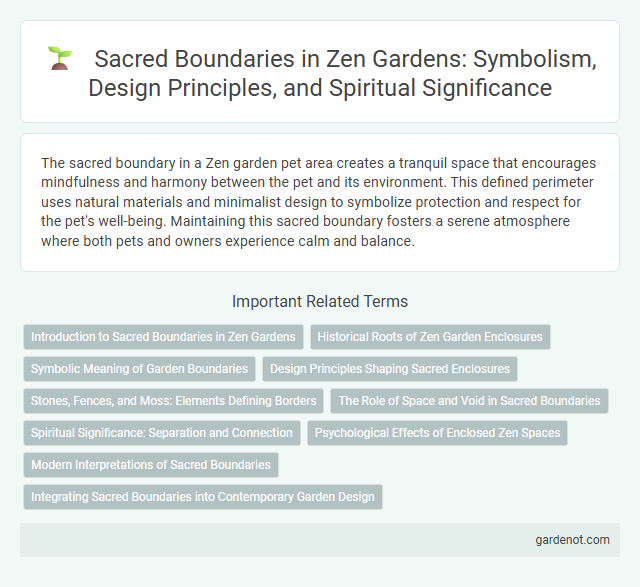The sacred boundary in a Zen garden pet area creates a tranquil space that encourages mindfulness and harmony between the pet and its environment. This defined perimeter uses natural materials and minimalist design to symbolize protection and respect for the pet's well-being. Maintaining this sacred boundary fosters a serene atmosphere where both pets and owners experience calm and balance.
Introduction to Sacred Boundaries in Zen Gardens
Sacred boundaries in Zen gardens define the physical and symbolic limits that create a tranquil, contemplative space separate from the outside world. These boundaries are often marked by stones, bamboo fences, or carefully placed plants, emphasizing simplicity and harmony with nature. They establish a spiritual perimeter that encourages mindfulness and introspection within the garden.
Historical Roots of Zen Garden Enclosures
Zen garden enclosures, known as sacred boundaries, originate from Japanese temple practices dating back to the Muromachi period (1336-1573). These boundaries delineate a meditative space, emphasizing separation from the ordinary world to enhance spiritual focus and tranquility. Historically, enclosure designs incorporated natural elements like bamboo fences and stone walls, reflecting Zen principles of simplicity and harmony.
Symbolic Meaning of Garden Boundaries
Garden boundaries in Zen gardens represent sacred limits that separate the cultivated space from the external world, embodying a symbolic threshold between tranquility and chaos. These boundaries often incorporate natural elements such as rocks, bamboo fences, or earth mounds, reinforcing the spiritual enclosure and fostering meditation. The deliberate design of these sacred borders emphasizes mindfulness and the harmonious relationship between humans and nature.
Design Principles Shaping Sacred Enclosures
Sacred boundaries in Zen gardens emphasize simplicity, asymmetry, and natural materials to create a contemplative space that fosters mindfulness. Design principles incorporate raked gravel patterns, stone arrangements, and carefully positioned plants to define the enclosure's spiritual perimeter without physical barriers. These elements collectively evoke tranquility and a sense of sacredness, reinforcing the garden's role as a meditative sanctuary.
Stones, Fences, and Moss: Elements Defining Borders
Stones, fences, and moss serve as essential sacred boundaries in Zen gardens, delineating space while promoting tranquility and spiritual focus. Stones often symbolize mountains or islands, creating natural borders that guide the viewer's meditation. Moss adds a soft, organic texture that subtly defines edges, while fences provide a physical and symbolic enclosure, marking the garden as a contemplative sanctuary.
The Role of Space and Void in Sacred Boundaries
Sacred boundaries in Zen gardens delineate space using void to invoke tranquility and contemplation, emphasizing emptiness as a vital element in spiritual practice. The deliberate placement of rocks, sand, and minimal vegetation creates a harmonious balance between form and formlessness, guiding the observer's mind toward mindfulness. This interplay of spatial design enhances the meditative atmosphere, reinforcing the garden's role as a sanctuary for inner peace.
Spiritual Significance: Separation and Connection
The sacred boundary in a Zen garden symbolizes the delicate balance between separation and connection, creating a space set apart from the ordinary world to foster spiritual reflection. This defined perimeter encourages mindfulness by marking a transition into a contemplative environment where the inner self connects with universal harmony. Through deliberate enclosure, the boundary enhances the garden's role as a sanctuary for meditation and spiritual awakening.
Psychological Effects of Enclosed Zen Spaces
Sacred boundaries within Zen gardens create a defined space that fosters deep psychological immersion and mental clarity. Enclosed Zen spaces promote mindfulness and stress reduction by limiting external distractions, encouraging introspection and a sense of tranquility. The psychological effects of these boundaries include enhanced focus, emotional balance, and a heightened connection to the present moment.
Modern Interpretations of Sacred Boundaries
Modern interpretations of sacred boundaries in Zen gardens emphasize the seamless integration of natural elements with spatial design to create meditative environments. These boundaries often use minimalist arrangements of rocks, plants, and water features to symbolize the transition between the mundane and the spiritual. Contemporary designers prioritize subtle markers that invite mindfulness without overt barriers, enhancing the garden's contemplative experience.
Integrating Sacred Boundaries into Contemporary Garden Design
Integrating sacred boundaries into contemporary garden design enhances the spiritual ambiance and creates a distinct space for meditation and reflection. Elements such as stone walls, carefully placed plants, and symbolic markers define these sacred perimeters, fostering a sense of tranquility and reverence within the garden. This approach not only honors traditional Zen aesthetics but also aligns with modern landscape architecture principles, emphasizing harmony and mindful spatial organization.
Sacred boundary Infographic

 gardenot.com
gardenot.com